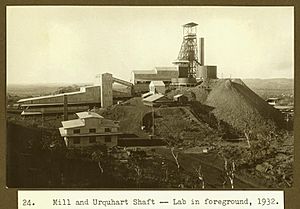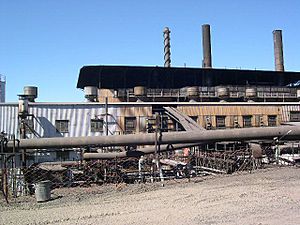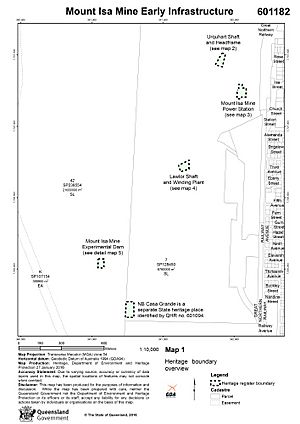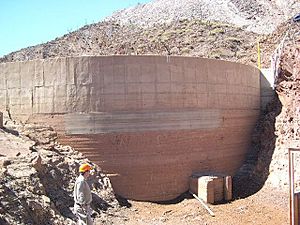Mount Isa Mine Early Infrastructure facts for kids
Quick facts for kids Mount Isa Mine Early Infrastructure |
|
|---|---|
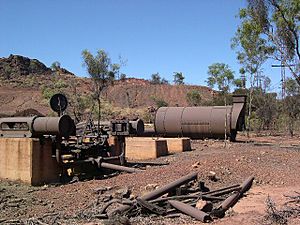
Lawlor Shaft and Winding Plant, 2003
|
|
| Location | on Mount Isa Mine Lease, Mount Isa (locality), City of Mount Isa, Queensland, Australia |
| Design period | 1919 - 1930s (interwar period) |
| Built | 1924 - c. 1963 |
| Official name: Mount Isa Mine Early Infrastructure, Lawlor Shaft and Winding Plant, Mount Isa Mine Experimental Dam, Mount Isa Mine Power Station | |
| Type | state heritage (built, archaeological) |
| Designated | 25 February 2005 |
| Reference no. | 601182 |
| Significant period | 1920s-c. 1963 (fabric) |
| Significant components | engine/generator shed/room / power supply, headframe, mullock heap, mounting block/stand, machinery/plant/equipment - mining/mineral processing, weir, shaft |
| Lua error in Module:Location_map at line 420: attempt to index field 'wikibase' (a nil value). | |
Mount Isa Mine Early Infrastructure is a collection of old mining buildings and equipment. These important historical sites are located on the Mount Isa Mine Lease in Queensland, Australia. They include the Lawlor Shaft & Winding Plant, the Urquhart Shaft and Headframe, the Mount Isa Mine Experimental Dam, and the Mount Isa Mine Power Station.
These structures were built between 1924 and about 1963. They were added to the Queensland Heritage Register on February 25, 2005. This means they are protected because they are important to Queensland's history.
Contents
Discovering Mount Isa's Mining Past
The valuable lead ores of Mount Isa were found by John Campbell Miles in early 1923. It was a late discovery for an area that had been explored for almost 60 years. Most prospectors in Queensland were looking for copper or gold, not lead.
By the end of 1923, 118 mining areas, called "leases," had been claimed. William Henry Corbould bought 51 of these leases. In January 1924, Corbould started the Mount Isa Mining Company. Soon after, two other companies were formed, but by December 1925, Mount Isa Mines bought them both. This meant one company owned almost all the mineral-rich land.
The Queensland government supported this new mining project. They even let a government geologist, EC Saint-Smith, work as the general manager for six months. In 1925, a law was passed to build a railway from Duchess to Mount Isa.
Getting the Mine Started
In 1924, Mount Isa Mines dug 33 shafts. They soon realized they would need a huge amount of money to develop the mine. William Corbould traveled to London many times between 1924 and 1927 to find investors.
In June 1927, a company called Russo-Asiatic Consolidated took over the mine's operations. This company was led by Leslie Urquhart. Corbould resigned but stayed on as an advisor. The new company's financial plan helped Mount Isa's development. American engineers created plans for exploring the ore and processing it. In 1928, Urquhart visited Mount Isa to see plans for a large dam, housing for workers, and a schedule for mining and processing.
Lawlor Shaft and Winding Plant (1920s)
Robert Lawlor owned the Crystal Lease in 1923. This lease became part of Mount Isa Mines by the end of 1924. Lawlor's Shaft was the main way to reach the ore during the early exploration phase (1925-1929). Pictures of the headframe and other buildings appeared in a mining journal in 1929.
In 1930, the Rio Grande mine was described as using the Lawlor Shaft. This shaft went down 54.4 meters. Diamond drilling showed that the ore went down to 305 meters. We don't know exactly when the Lawlor Shaft stopped working. It was used for copper mining during World War II.
Urquhart Shaft and Headframe (1930-1931)
Early on, it was thought that each ore body would need its own shaft. Ore would then be carried by railway to a central processing plant. However, after more drilling, it was found that the ore bodies were close enough to be worked cheaply. An underground railway could link them to central shafts.
Charles Mitke designed the Man and Supply shaft for workers and materials. The Urquhart shaft was designed to lift the ore and pump out water. Mitke oversaw the digging of the Urquhart shaft in 1929. It was finished by the time the Mount Isa Mines complex officially opened on June 15, 1931.
The Urquhart shaft went down about 0.5 miles (800 meters). It moved 3 million long tons of ore and rock each year. It operated for over 30 years until the K57 ore shaft opened in 1963.
Mount Isa Mine Power Station (1931)
From mid-1927, the Urquhart group managed the Mount Isa Mine. They wanted to build the "most modern mine of the age." The first power house was replaced by a new power station in 1931. It had a coal-fired boiler house and a generator house. This new station was designed by JM Callow in 1928.
The power station supplied electricity to the town and the mine. This continued until the Mica Creek power station opened. In 1951, the power station was made bigger to supply a new copper smelter. When Mica Creek took over electricity, the mine's power station started supplying compressed air for the entire mine. It still does this today.
Mount Isa Mine Experimental Dam (1920s)
When John Campbell Miles found the lead ores in 1923, a lack of water was a big problem. Small water holes were dug in the Leichhardt River. The Experimental Dam was built around this time. It had a weir at the entrance to a narrow valley called Hidden Valley.
The original stone wall of the weir was later made taller with concrete. Mount Isa Mines knew that the processing plants would need a lot of water. So, a surveyor suggested building the Rifle Creek Dam, 32 km south of the mine. This dam was built by mid-1929. A pipeline brought water to Mount Isa by 1930. After this, the Experimental Dam was no longer needed for water supply. It was then used for fun activities like swimming.
What the Early Infrastructure Looks Like Today
The Mount Isa Mine Early Infrastructure includes:
- Lawlor Shaft and Winding Plant
- Urquhart Shaft and Headframe
- Mount Isa Mine Power Station
- Mount Isa Mine Experimental Dam
Lawlor Shaft and Winding Plant
What's left of the Winding Plant is a steam winding engine. It was made by May Brothers Engineers in Gawler. It sits on concrete bases. Nearby are more concrete bases, possibly for an air compressor. A boiler is also located there, with its iron chimney lying next to it.
The entrance to the Lawlor Shaft is now covered with a grid for safety. It's located near the main mine road and an old residential area called King's Cross.
Urquhart Shaft and Headframe
An intact steel headframe stands over the Urquhart shaft. This headframe is a well-known symbol of Mount Isa Mines and the City of Mount Isa. It was made by F Rodingham Iron & Steel Co Ltd. in England. The concrete bases of the original winding plant are still there.
This headframe used to lift ore and drop it into a primary crusher. The crusher itself has been removed, but its concrete structure remains. From here, the ore was sent to the concentrator mills. The Urquhart shaft's winding engine has been moved to a tourist park in town. The old shed that housed it has also been removed.
Mount Isa Mine Power Station
The mine power station is at the base of the Urquhart Shaft hill. It has two parts: a boiler and furnace house, and a turbine-generator powerhouse. The outside of the building looks mostly the same since it was built. However, the inside has been changed and updated over time.
The power station used to burn coal. Now, the boiler house uses natural gas and oil. It also uses waste heat to power compressors. These compressors produce compressed air for the entire mine. The powerhouse building has been updated since the 1950s. One early generator, made by The General Electric Co Ltd. in England, still remains. The mine now gets its main power from the Mica Creek power station.
Mount Isa Mine Experimental Dam
The dam is a curved stone weir. It has concrete additions on top. It's located in a narrow valley of Kennedy Creek. The wall shows how it was built in stages, getting taller and wider over time.
The original part was about 5 meters tall. Later, it was raised another 2 meters with concrete. The weir is now 5 meters above the current silt level and is 23 meters wide. This dam shows how important water storage was for early mining operations.
Why These Sites Are Important
The Mount Isa Mine Early Infrastructure was added to the Queensland Heritage Register in 2005. This is because these sites are very important for understanding Queensland's history.
- Showing History's Path: These structures show how large-scale mining began at Mount Isa in the 1920s and 1930s.
- Early Mining Evidence: The Lawlor Shaft and Winding Plant are the oldest surviving winding plant and shaft at Mount Isa. They are directly linked to the mine's early development from 1924.
- Innovative Design: The Urquhart Shaft and Headframe (1930–31) show the early growth of the mine. This headframe has an American A-frame design, which was new and popular at the time.
- Powering the Mine: The Mount Isa Mine Power Station (1929–31) was built with money and engineering from the United States. It provided power to the town and mine for many years.
- Water for Mining: The Mount Isa Mine Experimental Dam (1920s) is the earliest structure at Mount Isa Mine. It shows how important it was to store water for mining. Its small size today is a big contrast to the huge dams and open-cut mines of current operations.
Rare and Unique: The way the mine and its buildings were developed was rare for Queensland. Also, the steam winding engine at the Lawlor Shaft is a rare survivor. It shows how Australian-made equipment was used before heavy machinery was imported. The General Electric turbine generator in the Power Station is also a very rare piece of early equipment.
Learning from the Past: These sites could help us learn even more about how the Mount Isa Mine worked in its early days through archaeological studies. The Lawlor Shaft and Winding Plant can help us understand the long history of mining at Mount Isa.
Community Connection: These structures are strongly linked to Mount Isa Mines, which has been vital to Queensland's economy since the 1920s. The Urquhart Shaft and Headframe is the biggest and most visible of the surviving headframes. It has been a landmark for the community for over 60 years.


